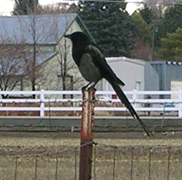
Courtesy Bridgerland Audubon Society Library
Stephen Peterson, Photographer
I knew a man who referred to those black and white, long-tailed birds as “Holstein Pheasants.”
He used to say, you can shoot pheasants, can’t you? Magpies are loved or hated. Few are without opinions when it comes to these protected, I remind you protected, birds.
In Asia, they are revered for good luck; while their relatives, the crows, are omens of bad luck.
The black-billed magpie of Utah is related to the yellow-billed magpies in California and more distantly to the European magpie and the Korean magpie.
They all have a similar general appearance, black and white with a long black tail.
Our Black-billed magpies mate for life and stay together until one dies. Then the other may find a new mate.
Their home-building skills will not produce awards for neatness on the outside. But are marvels of architecture.
Nests are collections of loose sticks, mud, bark and other available materials, often built on older nests. A hood of loose sticks covers the nest with multiple entrances.
And the inside is lined with soft grasses and other materials.
Once the nest is built, the female lays six or seven eggs. While she sets on the eggs, the male feeds her for up to 18 days. The parents feed their young about two months, even though the young fledge in about a month. Upon independence from their parents, the young flock with other young magpies.
Magpies can be seen harassing hawks, eagles and owls as they perch in trees.
But despite the begrudging landlords, owls and hawks often take up residence in old magpie nests.
Bold and gregarious, magpies are well adapted to man. They are the bane of back yard bird feeders, driving songbirds away and eating everything in sight.
I know at least one local birder, however, who enjoys magpies and attracts them with Cheetos and soft cat food, but on the other side of the house from her regular bird feeders.
Magpies are opportunists and nest raiders. They are despised by hunters because they clean out unprotected and abandoned nests.
And fruit growers fight them with netting, flags and pyrotechnics. But don’t hold that against them.
These Holsteins clean up roadkill, tent caterpillars, grasshoppers and many other things that we’d rather not see or smell.
For Wild About Utah, I’m Dick Hurren.
Credits:
Photos: Courtesy Bridgerland Audubon Society Image Files
Text: Lyle Bingham and Dick Hurren, Bridgerland Audubon Society
Additional Reading:
Cornell Lab of Ornithology: All About Birds, Black-Billed Magpie, https://www.birds.cornell.edu/AllAboutBirds/BirdGuide/Black-billed_Magpie_dtl.html, Accessed July 31, 2008
https://www.enature.com/flashcard/show_flash_card.asp?recordNumber=BD0032, Accessed July 31, 2008
https://www.birdweb.org/birdweb/bird_details.aspx?id=315, Accessed July 31, 2008
https://wdfw.wa.gov/wlm/living/magpies.htm, Accessed July 31, 2008
